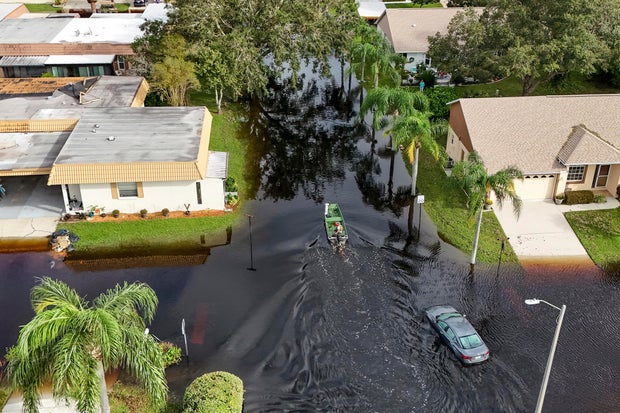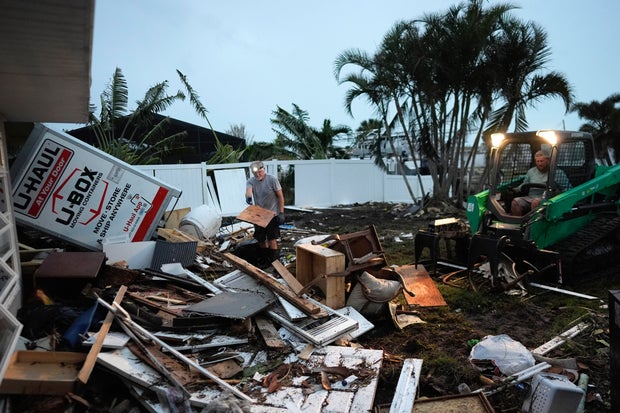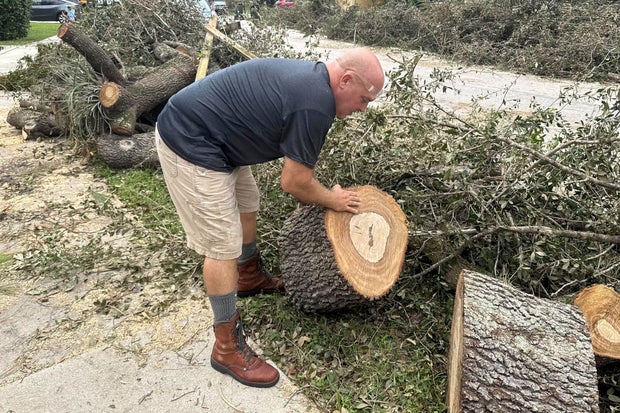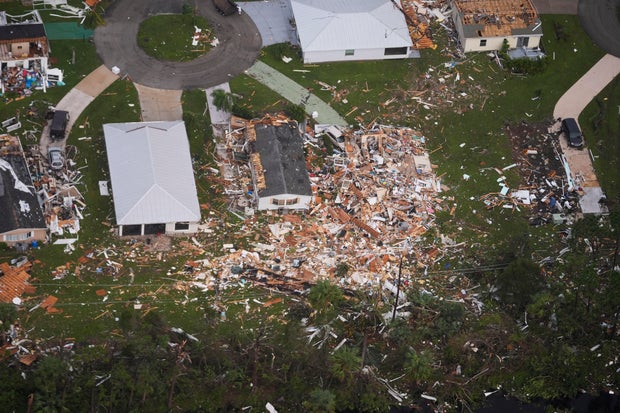CBS News
Harris to release medical records as campaign looks to pressure Trump to do the same

Vice President Kamala Harris is expected to release her medical history and records Saturday, as her campaign is now planning to put pressure on former President Donald Trump to release his own.
The report will say the 59-year-old Harris has the physical and mental resiliency to serve as president, according to a senior Harris aide.
It is unknown yet how detailed Harris’ records will be, but her campaign views the release as an opportunity to turn the conversation towards the physical health and mental acuity of her opponent, the 78-year-old Trump. Harris’ advisers argue they can contrast her age and Trump’s — daring him to disclose more recent information.
Harris did not release her medical records during the 2020 campaign. In November 2023, Trump posted a letter from his doctor of osteopathic medicine, Bruce Aronwald, that said he had been examined in September 2023 and that his “overall health is excellent.” No specifics on his vitals or medications were shared.
In an interview with CBS News in August, Trump said he would “gladly” release his medical records and that he recently had a medical exam and had a “perfect score.”
If elected in November, Trump would be the oldest president in U.S. history by the end of his term.
The Harris campaign’s attempt to highlight Trump’s age mirrors the Republican campaign’s approach to President Biden while he was the candidate. When Biden was still running, Trump’s campaign would often post clips of him stumbling up the stairs of Air Force One, or of his verbal gaffes.
Biden left the 2024 race in July after Democratic infighting and skepticism he could serve a full second term, which was spurred by a June debate performance where he appeared to show signs of his age, 81, by speaking with a hoarse voice and stumbling through answers.
On social media, Harris’ campaign has been leaning into references to Trump’s age, pointing out moments where Trump slurs his words or meanders.
“Americans are tired of your lies and slur-filled delusions. It’s getting…old,” the Kamala HQ X account posted in August.
CBS News
Floridians continue to clean up from Hurricane Milton, with over 1 million still without power

Florida residents who fled hundreds of miles to escape Hurricane Milton made slow trips home on crowded highways, weary from their long journeys and the cleanup work awaiting them but also grateful to be coming back alive.
“I love my house, but I’m not dying in it,” Fred Neuman said Friday while walking his dog outside a rest stop off Interstate 75 north of Tampa.
Neuman and his wife live in Siesta Key, where Milton made landfall Wednesday night as a powerful, Category 3 hurricane. Heeding local evacuation orders ahead of the storm, they drove nearly 500 miles to Destin on the Florida Panhandle. Neighbors told the couple the hurricane destroyed their carport and inflicted other damage but Neuman shrugged, saying their insurance should cover it.
Mike Carlson / AP
About 30 miles north in Zephyrhills, a CBS News crew joined the Pasco County Fire Rescue team as they waded through the water to ensure everyone got out of their homes safely.
“These are all brand new homes. These were all built within the last year and a half to two years, so they obviously went a little higher on the ground for them and they’re good still but … the original homes in this neighborhood are suffering the consequences of the three hurricanes,” a rescuer told CBS News.
The golf course community has faced flooding from hurricanes Debby, Helene and Milton, leaving the already saturated ground with little room to handle even more water.
Lee and Pamela Essenburm evacuated their home in Palmetto, on the south end of Tampa Bay, fearing Milton might hit as a catastrophic Category 4 or 5 storm.
“I wasn’t going to take a chance on it,” Lee Essenbaum said. “It’s not worth it.”
Rebecca Blackwell / AP
Milton killed at least 17 people when it tore across central Florida on Wednesday, flooding barrier islands, ripping the roof off the Tampa Bay Rays’ baseball stadium and spawning deadly tornadoes.
Officials say the toll could have been worse if not for the widespread evacuations.
The still-fresh devastation wrought by Hurricane Helene just two weeks earlier probably helped compel many people to flee.
“Helene likely provided a stark reminder of how vulnerable certain areas are to storms, particularly coastal regions,” said Craig Fugate, who served as administrator for the Federal Emergency Management Agency under President Barack Obama. “When people see firsthand what can happen, especially in neighboring areas, it can drive behavior change in future storms.”
About 1.6 million customers in Florida remained without power Saturday morning, according to Find Energy. The White House said 50,000 workers, many from across the U.S. are working to restore power.

“This is ridiculous. We need power out here. We need help out here,” said Mia Watson, a resident of Palm Beach Gardens.
Tornadoes wrought unexpected damage
Tony Brazzale, a diving boat captain who has lived for 10 years in his Wellington home in southeastern Florida, wasn’t worried about Hurricane Milton. The storm’s center was forecast to land on the opposite side of the peninsula and then cross the state well to the north of his family.
But on Wednesday afternoon as the hurricane began to pummel the state, he stood outside his house and watched as a tornado loomed in the sky. He took a video on his phone. The pressure dropped, and his wife said her ears were popping. It was time to go inside.
Stephany Matat / AP
The twister shattered windows in the home, tore off roof shingles, ripped a tree from the ground and left branches and other debris scattered in the yard. Two days later Brazzale was wearing safety goggles and using a chainsaw as he cleaned up the damage.
“The hurricane was a nonevent for us,” he said. “Had it not been for an F-3 tornado, the entire thing would have been a nonevent for us.”
It was one of dozens of tornadoes spawned by Milton that hit South Florida far from where the storm made landfall near Sarasota. One of them killed at least six people in Spanish Lakes Country Club Village near Fort Pierce, about an hour’s drive north from Wellington.
Meteorologists believe there may have been at least 38 tornadoes associated with Milton. The National Weather Service is still reviewing preliminary reports, which could take weeks, but it issued 126 tornado warnings in the state the day the hurricane hit.
Gerald Herbert / AP
When the review is complete, the storm could crack the all-time top-10 list for most tornadoes caused by a hurricane.
One of those twisters narrowly missed Tom Perusi’s home, but it easily tossed his boat.
“We went into the bathroom, our concrete bathroom and stayed there,” he told CBS News. “And with the whole shook it, just everything shook. And when we got out, I took it serious. I thought I was all ready. I was ready for everything, not a tornado.”
Gov. Ron DeSantis warned people to not let down their guard, however, citing ongoing safety threats including downed power lines and standing water that could hide dangerous objects.
“We’re now in the period where you have fatalities that are preventable,” DeSantis said Friday. “You have to make the proper decisions and know that there are hazards out there.”
contributed to this report.
CBS News
Transit systems are focusing on fare evaders to win back riders who are wary about crime

Dominique Davenport was waiting for a ride home after getting off the MetroLink light rail one night in East St. Louis, Illinois, when he heard an argument followed by gunshots behind him on the station’s platform.
A teenager had been killed, the latest act of violence for a St. Louis-area transit system with a reputation for crime and where anyone could board without even showing a ticket.
“You could just be getting off work and somebody gets an attitude,” Davenport said. “Big drug addicts, drug dealers, you’ve got so many different personalities, so many different types of people who go through things. And everybody catches the train.”
As transportation hubs across the country attempt to win back riders who haven’t returned since the pandemic — 26% as of September 2023 — one major obstacle is the sometimes inaccurate perception that transit crime is on the rise. Many systems are bulking up enforcement and targeting their efforts on people who try to ride without paying.
MetroLink has begun adding 8-foot (2.4-meter) metal gates to ensure customers can’t enter the platform without a valid fare card. That’s a major change from the honor system the two-state light rail had employed since its inception in 1993, with fares only enforced through onboard spot checks and the threat of fines for repeat violators.
Transit systems in other metropolitan areas such as New York, Chicago, Washington, D.C., Philadelphia and San Francisco, already required upfront payments, but lately they have been fortifying the entrance gates to curb the temptation for riders to simply hurdle a turnstile.
Jeff Roberson / AP
Does cracking down on ticketless riders help stop violent crime?
As Janno Lieber, chairman and CEO of New York’s Metropolitan Transportation Authority, explained, “not every fare evader is a criminal” but virtually all criminals “evaded the fare.”
The new gates being installed at the St. Louis-area MetroLink stations are commonly known elsewhere as “fare gates.” But Kevin Scott, general manager for security at Bi-State Development, the agency overseeing transit in the region, is quick to correct the reference. They are “security gates,” he says, stressing that the $52 million purchase, which also includes the addition of 1,200 regularly monitored cameras, is less about catching fare-skippers than improving safety.
“We’ve seen it time and again where something plays out on the street, then everybody runs for the MetroLink platform and that’s where the shooting happens or that’s where the stabbing happens,” Scott said. “We’re really trying to impact the overall perception that the system is unsafe. We could have taken five or six steps forward with security, but if we have an incident play out, now we’re three or four steps back.”
Assaults and homicides on public transit roughly doubled between 2011 and 2023, according to the Federal Transit Administration. Several transit agencies, including the St. Louis MetroLink, have reported a recent drop in crime.
There is less current national data about the link between crime and fare evasion. However, people who didn’t pay a fare accounted for nearly 94% of those arrested for violent crimes on the Los Angeles Metro from May 2023 through April 2024. Metro is testing taller fare gates and some stations now require customers to tap a card when they exit as well as enter.
Joshua Schank, who wrote a report for the Mineta Transportation Institute examining whether transit should be free, said gated entrances are emblematic of the major question at the root of public transportation: Should it be a service for everybody or just those who can afford to ride?
“There’s a tendency to default to the idea that enforcing fares or putting up fare gates is a security solution because it’s something concrete you can do,” said Schank, a partner with InfraStrategies. “Maybe that is the answer, but it’s worth exploring other behavioral elements to improve security and not just defaulting to fare gates.”
Subway system operations nationwide
New York’s subway system has long been notorious for fare evasion, with one widely watched YouTube video showing a man squeezing through a turnstile just by pulling it slightly backward, and another showing five people crowding through a gate after paying just one fare. Earlier this year, more than 1,400 turnstiles were modified to prevent slipping through and other alterations are being tested to make them harder to jump over.
Like New York, the Metro subway system in Washington, D.C., has been working to make its gates higher while beefing up patrols for unpaid riders. Police have written more than 10,000 citations for fare evasion this year, nearly three times the number from the same period last year. More than 250 people who were caught skipping a fare were arrested for open warrants and 16 guns were recovered.
But in New York, the new surge in bus fare evasion is costing millions of dollars, just as the cash-strapped Metropolitan Transportation Agency is in dire need of new funds to upgrade its aging system. Every single day, close to 1 million bus riders — 48% — board without paying the fare, which is more than double since the pandemic, according to CBS New York. In 2020, 21% of bus riders boarded without paying. Part of the reason for that is that buses were free during the pandemic and officials say it’s hard to put that genie back in the bottle.
Recently, an MTA pilot program that gave New Yorkers free bus rides in all five boroughs ended after a report exposed the high rates of fare evasion across the transit system.
Last month, four people were shot to death while sleeping on an elevated train in Chicago. Gate improvements already had been part of the Chicago Transit Authority’s plan to bolster security at L stations, along with better patrols and a pilot program to detect guns.
Bay Area Rapid Transit in San Francisco has had fare gates since it opened in 1972, but until 2018 an officer had to actually witness someone evading a fare to write a ticket. Now, customers risk fines if they don’t carry proof of payment or a fare card. Also, every gate is being reinforced with security wings, which spokesman Jim Allison says are nearly impossible to push open “unless you’re an NFL linebacker and take a full run at it.”
“We began to view fare evasion a little differently, as not just a cost of doing business but also a cultural liability,” Allison said. “There was a sense that because so many people were observing fare evaders, it was eroding trust in the system.”
Sound Transit, which operates the regional light rail system in the Seattle area, has never had fare gates and has no plans to add them after one study concluded the systemwide cost could approach $200 million.
The Southeastern Pennsylvania Transportation Authority in Philadelphia estimates it loses as much as $68 million annually due to fare evasion. Still, seldom do expensive new gates like the glass ones SEPTA is installing quickly pay for themselves through more effective toll enforcement.
That’s why many systems, including the St. Louis MetroLink, justify the purchase less through a financial lens than through other factors such as security and fairness.
The Jackie Joyner-Kersee Center station near where Davenport works in East St. Louis was among the first to be upgraded. Until the fare card system becomes operational, workers open the gate manually when customers show proof of payment.
“I like it,” Davenport said. “If they know you’re going to pay your fare and take the train home, they’re going to let you through.”
CBS News
Exclusive discounts from CBS Mornings Deals

Watch CBS News
Be the first to know
Get browser notifications for breaking news, live events, and exclusive reporting.














